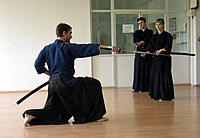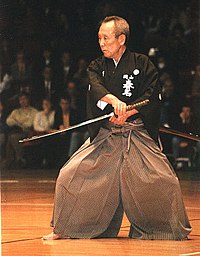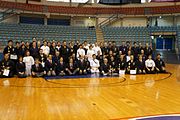| It has been suggested that [[::Iaijutsu|Iaijutsu]] be merged into this article. (Discuss) Proposed since November 2013. |
 | |
 | |
| Focus | Weaponry |
|---|---|
| Hardness | Forms competitions only. |
| Country of origin |
|
| Parenthood | Iaijutsu[1][2] |
| Olympic sport | No |
| Official website |
International Kendo Federation (FIK): http://www.kendo-fik.org/ |
Iaido (居合道 Iaidō), abbreviated with iai (居合),[3] is a modern Japanese martial art/sport[4]
Iaido is associated with the smooth, controlled movements of drawing the sword from its scabbard or saya, striking or cutting an opponent, removing blood from the blade, and then replacing the sword in the scabbard.[1] While new practitioners of iaido[5] may start learning with a wooden sword (bokken) depending on the teaching style of a particular instructor, most of the practitioners use the blunt edged sword, called iaitō.[6] Few, more experienced, iaido practitioners use a sharp edged sword (shinken).[7]
Practitioners of iaido are often referred to as iaidoka.[8]
Origins of the name[]

Late Haruna Matsuo sensei (1925-2002) demonstrating Muso Jikiden Eishin Ryu kata Ukenagashi
The term 'iaido' appear in 1932 and consists of the kanji characters 居合道.[9][10] The origin of the first two characters, iai (居合), is believed to come from saying Tsune ni ite, kyu ni awasu (常に居て、急に合わす), that can be roughly translated as “being constantly (prepared), match/meet (the opposition) immediately”.[11] Thus the primary emphasis in 'iai' is on the psychological state of being present (居). The secondary emphasis is on drawing the sword and responding to the sudden attack as quickly as possible (合).
Last character, 道 is generally translated into English as the way. The term 'iaido' approximately translates into English as "the way of mental presence and immediate reaction",[9][12] and was popularized by Nakayama Hakudo.[9]
The term emerged from the general trend to replace the suffix -jutsu (術) with -dō (道) in Japanese martial arts in order to emphasize a philosophical or spiritual aspects of practice.[9][13]
Purpose of iaido[]
Iaido emcompasses hundreds of styles of swordsmanship, all of which subscribe to non-combative aims and purposes. Iaido is an intrinsic form of Japanese modern budo.[9] Iaido is a reflection of the morals of the classical warrior and to build a spiritually harmonious person possessed of high intellect, sensitivity, and resolute will.[14]
Moral and religions influence on iaido[]
The metaphysical aspects in iaido has been influence of several philosophical - and religious directions. Iaido is a blend of the ethics of Confucianism, methods of Zen, the philosophical Taoism and aspects from bushido.[15]
Seitei-gata techniques[]
Because iaido is practiced with a weapon, it is almost entirely practiced using forms, or kata. Multiple person kata exist within some schools of iaido, when iaidoka will usually use bokken for such kata practice. Iaido does include competition in form of kata but does not use sparring of any kind. Because of this non-fighting aspect, and iaido's emphasis on precise, controlled, fluid motion, it is sometimes referred to as "moving Zen."[12]
Iaido forms (kata) are performed solitarily against one or more imaginary opponents. Some iaido schools, however, include kata performed in pairs. Most of the styles and schools do not practice tameshigiri, cutting techniques.
A part of iaido, is nukitsuke.[16] This is a quick draw of the sword, accomplished by simultaneously drawing the sword from the saya and also moving the saya back in saya-biki.[17]
History[]
- Early history (prior to the Meiji Restoration in 1868) read more in the article Iaijutsu.
After the collapse of the Japanese feudal system in 1868 the founders of the modern disciplines borrowed from the theory and the practice of classical disciplines as they had studied or practiced.[18] The founding in 1895 of the Dai Nippon Butoku Kai (DNBK) 大日本武徳会 (lit. "Greater Japan Martial Virtue Society") in Kyoto, Japan.[19] was also an important contribution to the development of modern Japanese swordsmanship. In 1932 DNBK officially approved and recognized the Japanese disciplin, iaido;[20] this year was the first time the term iaido appeared in Japan.[9][12] After this initiative the modern forms of swordsmanship is organised in several iaido organisations.[2]
On 7 December 1941, Japan attacked the US naval base at Pearl Harbor and declared war, bringing the US into World War II.[21][22] After the Soviet invasion of Manchuria and the atomic bombings of Hiroshima and Nagasaki in 1945, Japan agreed to an unconditional surrender on 15 August.[23]
As a result, the Dai Nippon Butoku Kai and its affiliates were disbanded by the Allies of World War II in the period 1945-1950. In 1950 when the Dai Nippon Butoku Kai was reestablished and the practice of the Japanese martial disciplines took up their activities again, including iaido.[24] In 1952, the Kokusai Budoin, International Martial Arts Federation (国際武道院・国際武道連盟 Kokusai Budoin Kokusai Budo Renmei) (IMAF) was founded in Tokyo, Japan.[25] IMAF is a Japanese organization promoting international Budō,[26] and has seven divisions representing the various Japanese martial arts, including iaido.[27][28]
In 1952, the All Japan Kendo Federation (ZNKR) was founded,[29] and the All Japan Iaido Federation (ZNIR) was founded in 1948.
Upon formation of various organizations overseeing martial arts, a problem of commonality appeared.[citation needed] Since members of the organization were drawn from various backgrounds, and had experience practicing different schools of iaido, there arose a need for a common set of kata, that would be known by all members of organization, and that could be used for fair grading of practitioner's skill. Two of the largest Japanese organizations, All Japan Kendo Federation (ZNKR)[29] and All Japan Iaido Federation (ZNIR), each created their own representative set of kata for this purpose.
Kata under the respective iaido orgaisations[]
Seitei Iaido[]
Seitei or Zen Nippon Kendo Renmei Iaido (制定) ("basis of the Iaido") are technical based on seitei-gata, or standard form of sword-drawing techniques, created by the Zen Nihon Kendo Remmei (All Japan Kendo Federation) and the Zen Nihon Iaido Remmei (All Japan Iaido Federation).[30] This standard set of iaido kata was created in 1968 by a committee formed by the All Japan Kendo Federation (AJKF, Zen Nippon Kendo Renmei or ZNKR).[31] The twelve Seitei iaido forms (seitei-gata) are standardised for the tuition, promotion and propagation of iaido at the iaido clubs, that are members of the regional Kendo federations. All dojos, that are members of the regional Kendo federations teach this set. Since member federations of International Kendo Federation (FIK) uses seitei gata as a standard for their iaido exams and shiai, seitei iaido has become the most widely form of iaido in Japan and the rest of the world.
Tōhō Iaido[]
The All Japan Iaido Federation (ZNIR, Zen Nihon Iaido Renmei, founded 1948) has a set of five iaido forms, Tōhō Iaido.[citation needed] This is essentially the ZNIR equivalent of the Seitei Iaido set. These five forms are borrowed from the five different schools below.[citation needed]
- Musō Jikiden Eishin-ryū School founded during the Taishō era (1912-1926). (Include the technique 'maegiri')
- Mugai-ryū School founded in 1680. (Include the technique 'zengogiri')
- Shindō Munen-ryū School founded in the early 1700s. (Include the technique 'kiriage')
- Suiō-ryū School founded c. 1615. (Include the technique 'shihôgiri')
- Hōki-ryū School founded c. 1570. (Include the technique 'kissakigaeshi')
Other organizations[]
Single-style federations usually do not have a standardized "grading" set of kata, and use kata from their koryu curriculum for grading and demonstrations.[citation needed]
Iaido schools[]

Iaido in the Czech Republic
Many iaido organisations promote sword technique from the seiza (sitting position) and refer to their art as iaido. One of the popular versions of these is the Musō Shinden-ryū 夢想神伝流, a iaido system created by Nakayama Hakudō (1872-1958) in the 1932.[32] The Musō Shinden-ryū is an interpretation of one of the Jinsuke-Eishin lines, called Shimomura-ha.[33] The other line of Jinsuke-Eishin, called Tanimura-ha, was created by Gotō Magobei Masasuke] (d. 1898) and Ōe Masamichi Shikei (1852-1927). It was Ōe Masamichi Shikei who began formally referring his iaido branch as the Musō Jikiden Eishin-ryū 無双直伝英信流 during the Taishō era (1912-1926).[34]
Ranks in iaido[]
- Read more in the article Dan (rank).
The ranks in iaido is based on the modern kyu-dan system, created in 1883,[35] that conform to the policies and criteria established by the iaido organisation concerned.[35][36]
International Iaido Sport Competition[]

Medals and cups are a part of iaido in connection with sport games.
Iaido, in its modern form, is practiced as a competitive sport,[4] regulated by the All Japan Kendo Federation. The AJKF maintains the standardized iaido kata and etiquette, and organizes competetions.[8][37]
An iaido competition consists of two iaidoka performing their kata next to each other and simultaneously. The competitors will be judged by a panel of judges according to the standardized regulations.
European Kendo Federation has arranged iaido championships since 2000,[38] where this competition are held every year.[39]
The 2010 European Iaido Championship finals can be seen at the following link to YouTube: Video from YouTube.
Iaido organisations[]
Many national and regional organisations manage and promote iaido activities. Organisations which on international level include iaido are following organisations:
Dai Nippon Butoku Kai (DNBK) established in 1895 in Kyoto,[19] approved and recognized the discipline iaido.[20]
The International Martial Arts Federation (IMAF) was established in Kyoto in 1952 and is dedicated to the promotion and development of the martial arts worldwide,[25] including iaido.[27]
International Kendo Federation (FIK), established in 1970, an international organization for Kendo, Iaido and Jodo practitioners, which many national Kendo federations are a members of.[40]
See also[]
| Wikimedia Commons has media related to Iaido. |
External links[]
Following organisations are national iaido federations in Japan:
- All Japan Kendo Federation (ZNKR/AJKF), a national organization for Kendo, Iaido and Jodo practitioners, member of FIK. (Japanese)
- Dai Nippon Butoku Kai (DNBK) in Kyoto, a national - and international organisation for iaido in Japan. (English)
- International Martial Arts Federation (IMAF) in Kyoto, a national - and international organisation for iaido in Japan. (English)
- All Japan Iaido Federation (Specialized information site ZNIR). (Japanese)
- Japan Iaido Federation (Nippon Iaido Renmei/NIR). (English)
References[]
- ↑ 1.0 1.1 John Nauright, Charles Parrish, edited (2012) Sports Around the World: History, Culture, and Practice. ABC-CLIO. Page 226. ISBN 978-1-59884-300-2
- ↑ 2.0 2.1 Draeger, Donn F. (1974) Modern bujutsu & Budo - The Martial Arts and Ways of Japan. (Vol. III). New York: Weatherhill. Page 67-68. ISBN 0-8348-0351-8
- ↑ Hall, David A., ed (2012). "Encyclopedia of Japanese Martial Arts". New York, USA: Kodansha USA, Inc.. p. 168. ISBN 978-1-56836-410-0..
- ↑ 4.0 4.1 Christensen,Karen and Allen Guttmann et.al (2001) International Encyclopedia of Women and Sports: H-R. Macmillan Reference USA, Page 553.
- ↑ Katz, Mandy (2009-04-16). "Choose Your Weapon: Exotic Martial Arts". The New York Times. http://www.nytimes.com/2009/04/16/fashion/16physicalculture.html?pagewanted=2&%2334;H%C3%83%C2%A9lio%20gracie&sq&st=cse&%2334;&scp=3. Retrieved 2010-12-12.
- ↑ Armstrong, Hunter B (1995) The koryu Bujutsu Experience in Koryu Bujutsu - Classical Warrior Traditions of Japan (ed. by Diane Skoss).Koryu Books. Page 31. ISBN 1-890536-04-0
- ↑ Warner, Gordon, ed (1982). "Japanese Swordsmanship - Technique and Practice". Boston/London: Weatherhill. p. 102. ISBN 978-0-8348-0236-0..
- ↑ 8.0 8.1 Pellman, Leonard and Masayuki Shimabukuro (2008, 2nd edition) Flashing Steel: Mastering Eishin-Ryu Swordsmanship. Blue Snake Books. Page 314-315. ISBN 978-1-58394-197-3
- ↑ 9.0 9.1 9.2 9.3 9.4 9.5 Warner, Gordon, ed (1982). "Japanese Swordsmanship - Technique and Practice". Boston/London: Weatherhill. p. 79. ISBN 978-0-8348-0236-0..
- ↑ Draeger, Donn F. (1974) Modern Bujutsu & Budo - The Martial Arts and Ways of Japan. (Vol. III). New York: Weatherhill. Page 55-58. ISBN 0-8348-0351-8
- ↑ http://ejmas.com/tin/2010tin/tinart_thibedeau_1005.html
- ↑ 12.0 12.1 12.2 Shaw, Scott (1999) Samurai Zen. Chapter 12. Weiser Books. ISBN 978-1-57863-104-9
- ↑ Draeger, Donn F. (1974) Modern bujutsu & Budo - The Martial Arts and Ways of Japan. (Vol. III). New York: Weatherhill. Page 55-58. ISBN 0-8348-0351-8
- ↑ Warner, Gordon, ed (1982). "Japanese Swordsmanship - Technique and Practice". Boston/London: Weatherhill. p. 100. ISBN 978-0-8348-0236-0..
- ↑ Warner, Gordon, ed (1982). "Japanese Swordsmanship - Technique and Practice". Boston/London: Weatherhill. p. 101. ISBN 978-0-8348-0236-0..
- ↑ Suino, Nicklaus (2007) Strategy in Japanese Swordsmanship. Weatherhill. Page 38. ISBN 978-1-59030-489-1
- ↑ Craig, Darrell (1981) IAI The Art of Drawing the Sword. Tuttle Publishing. Page 64. ISBN 0-8048-7023-3
- ↑ Draeger Donn. F. (1974) Modern Bujutsu & Budo - The Martial Arts and Ways of Japan. New York/London: Weatherhill. Page 57. ISBN 0-8348-0351-8
- ↑ 19.0 19.1 Dai Nippon Butoku Kai: Honbu, Kyoto, Japan (2012). Retrieved on November 13, 2013.
- ↑ 20.0 20.1 Dai Nippon Butoku Kai: History and philosophy (2012). Retrieved on November 13, 2013.
- ↑ "インドネシア独立運動と日本とスカルノ(2)" (in Japanese). 馬 樹禮. 産経新聞社. April 2005. http://www.sankei.co.jp/seiron/koukoku/2005/0504/ronbun3-2.html. Retrieved 2 October 2009.
- ↑ "The Kingdom of the Netherlands Declares War with Japan". iBiblio. http://www.ibiblio.org/pha/policy/1941/411208c.html. Retrieved 2 October 2009.
- ↑ Pape, Robert A. (1993). "Why Japan Surrendered". pp. 154–201. Digital object identifier:10.2307/2539100.
- ↑ Draeger Donn. F. (1974) Modern Bujutsu & Budo - The Martial Arts and Ways of Japan. New York/London: Weatherhill. Page 48-49. ISBN 0-8348-0351-8
- ↑ 25.0 25.1 International Martial Arts Federation FAQ
- ↑ Journal of Combat Sports and Martial Arts. MEDSPORTPRESS, 2011; 1(2); Vol. 2, page 50.
- ↑ 27.0 27.1 http://www.imaf.com/divisions.html International Martial Arts Federation (IMAF) - Divisions.
- ↑ The East: Volume 36; Volume 36, 2000.
- ↑ 29.0 29.1 "The History of Kendo". All Japan Kendo Federation (AJKF). http://www.kendo-fik.org/english-page/english-page2/brief-history-of-kendo.htm.
- ↑ Draeger, Donn F., ed (1982). "modern Bujutsu & Budo - The Martial Arts and Ways of Japan.". New York/Tokyo: Weatherhill. p. 67. ISBN 0-8348-0351-8..
- ↑ All Japan Kendo Federation (2009). Zen Nippon Kendo Renmei Iai. Tokyo, Japan: All Japan Kendo Federation. pp. 50.
- ↑ Hall, David A., ed (2012). "Encyclopedia of Japanese Martial Arts". New York, USA: Kodansha USA, Inc.. p. 169. ISBN 978-1-56836-410-0..
- ↑ Warner, Gordon, ed (1982). "Japanese Swordsmanship - Technique and Practice". Boston/London: Weatherhill. p. 90. ISBN 978-0-8348-0236-0..
- ↑ Hall, David A., ed (2012). "Encyclopedia of Japanese Martial Arts". New York, USA: Kodansha USA, Inc.. p. 335. ISBN 978-1-56836-410-0..
- ↑ 35.0 35.1 http://books.google.com/books?id=fdcDAAAAMBAJ&pg=PA64&dq=black+belt+development+dan+system&hl=en&sa=X&ei=Cu_6UM-SOY3HtAaN2IHQDA&sqi=2&ved=0CDUQ6AEwAg#v=onepage&q=black%20belt%20development%20dan%20system&f=false Black Belt Magazine, May 1991. Page 64.
- ↑ Warner, Gordon, ed (1982). "Japanese Swordsmanship - Technique and Practice". Boston/London: Weatherhill. p. 64. ISBN 978-0-8348-0236-0..
- ↑ http://eicejc2008.kendo.ch/download/EIC%20Rules%202008.pdf Rules & Regulations of the 15th European Iaido Championships 2008.
- ↑ http://www.kendo-cik.it/Italiano/cik_iaido/europei/risultati_europei_iaido.htm
- ↑ http://www.ekf-eu.com/disci_page.cfm?type=3&disc=2 European Kendo Federation - Iaido Championships.
- ↑ "What is FIK". International Kendo Federation. http://www.kendo-fik.org/english-page/english-page2/What-is-IKF.htm.
The original article can be found at Iaido and the edit history here.